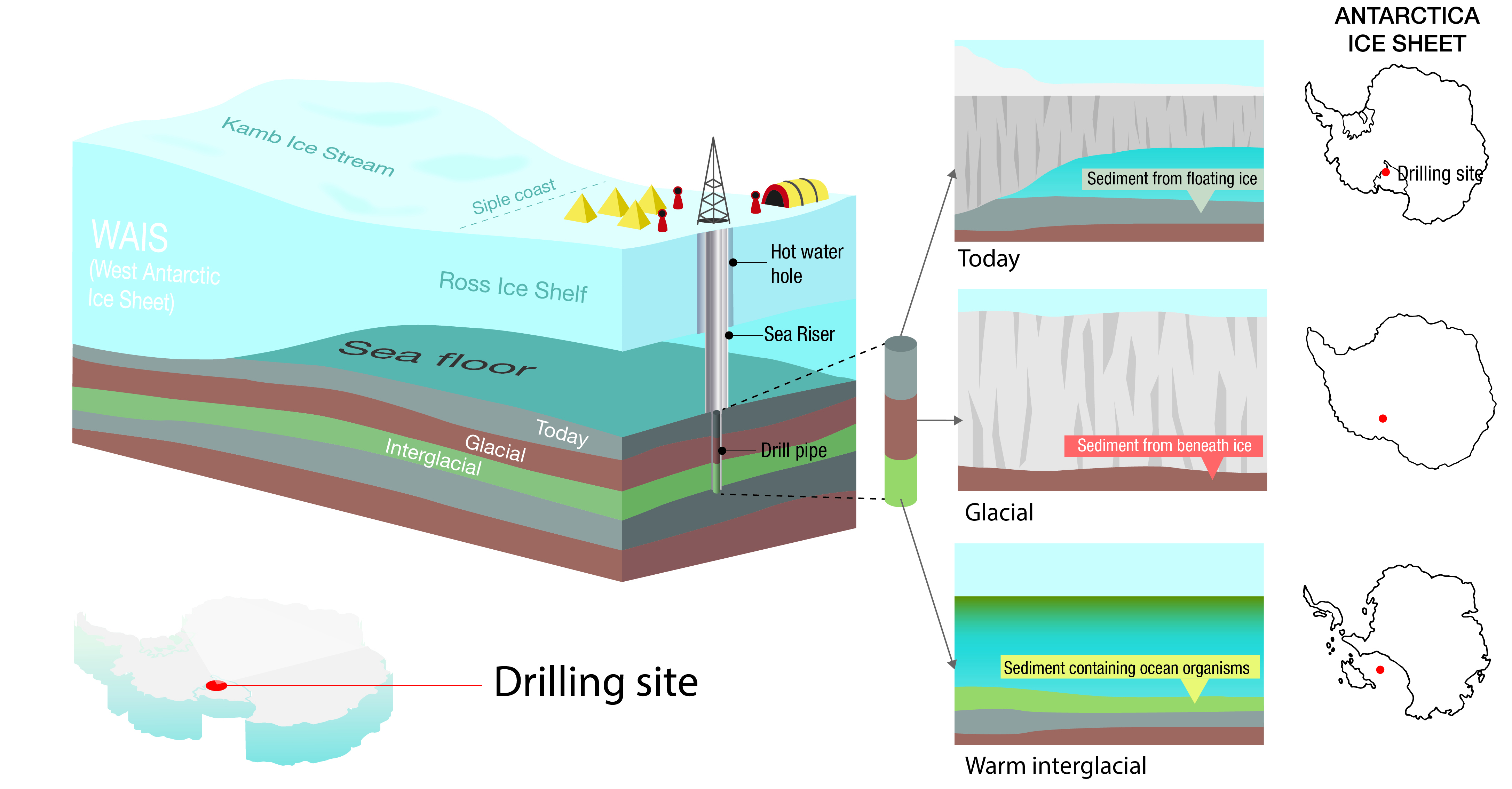Drilling
A team of engineers from Te Herenga Waka – Victoria University of Wellington and GNS Science have developed a new ice and sediment drilling system.
We will transport this drill system hundreds of kilometres across the Ross Ice Shelf to the Siple Coast. We will first use Te Herenga Waka’s Hot Water Drill to melt a 300-mm (12-inch) hole through floating ice with a hot water drill. Then a purpose-built light-weight sediment coring system co-owned by GNS Science and Te Herenga Waka will drill over a hundred meters (330 feet) into the seafloor. This transportable system is capable of recovering about 200 metres (660 feet) of sediment from beneath the seafloor in places where the combined depth of the ice shelf (or sea ice) and water column is over 1,000 metres (3,380 feet) thick.
You can’t just buy a drill like this off the shelf. It’s custom-built for the challenge. We are bringing together lots of different parts and pieces and adapting them to address our problem, which comes with a lot of unique challenges and workarounds. We have to carefully consider which spare parts we need to take, what we can, or absolutely cannot, do without. Because it’s not like you can pop down to the shop to get the part you need. Also, when everything is set up and operating, it must all fit into a tent that is only 15 metres long and 8 metres wide. Darcy Mandeno, Engineering Manager

We will use the Antarctic Intermediate Depth Drill system (AIDD system) to recover sediment cores from under the Ross Ice Shelf. The system refers to:
a glass reinforced epoxy riser
a MP1000 portable diamond core drill (sometimes called the drill rig), with custom developed accessories
the hot water drill will get integrated with the diamond core drill, where the hot water drill supplies hot water as a drilling fluid
The Kamb Ice Stream site (KIS-3) is 900 km (560 miles) from Scott Base (the New Zealand station) and McMurdo Station (USA’s primary base) as the skua flies and 1,150 km (715 miles) by overland traverse. The floating ice at KIS-3 is around 590 m (1,950 feet) thick, with an ocean cavity of around 30 m (100 feet) and a tidal range of around 2 m (7 feet). At KIS-3, we will melt a 35-cm (14-inch) diameter hole through the ice shelf with a hot water drill to access the ocean water cavity below.
We will position our purpose-built light-weight drilling rig and lower a series of linked fiberglass pipes (known as the riser) through the ice shelf hole to connect the surface to the seafloor.
A second series of linked steel pipes with a diamond encrusted rock coring bit is lowered inside the riser. It will core into layers of sediment and rock up to 200 m (660 feet) beneath the seafloor.
If we drill past half a metre (1.5 feet) below the seafloor at the site, we are in discovery mode because nobody has been able to drill as deep as we aim to go, and we expect some surprises as we drill past.
Once the hot water system has done its work, then we are racing the clock. We need to get the sediment drill in position fast to get those cores as quick as we can. This is as the ice hole will immediately start to close, shrinking at a rate of 5-10mm per hour. We will then switch from working day shifts to a 24/7 operation. If the hole freezes over, the drill will get stuck and its game over. Darcy Mandeno, Engineering Manager
Once we retrieve the cores from beneath the seafloor and bring them up to the ice shelf surface, the science team will work fast to X-ray the cores, complete some initial analyses, and ensure the cores are safely stored and kept in pristine condition for detailed study once they have been shipped to New Zealand, the USA, and laboratories around the world.
If things go to plan at the first site, the drilling system will be moved by tractor-train along a route through treacherous crevassed terrain to Crary Ice Rise. This is the second site of the SWAIS 2C Project and will be drilled in 2024. There is no ocean cavity at the Crary Ice Rise site, so we will drill through ice that is around 520m (1,700 feet) thick directly into sediment and rock from the base of the hole in the ice shelf.
The field team will also deploy oceanographic instruments beneath the ice shelf through the access hole made by the hot water drill.
The drilling system will then be available to use at other sites in Antarctica, but this all depends on societal needs, research priorities, and funding.
“That’s the beauty of the location and this project. It’s uncharted territory down there beneath the ice, beneath the seafloor. It's so close to the place where the ice sheet begins to float, nobody really knows what we will find. So, if the technology works and we can get those cores, then we open up a massive opportunity to make discoveries that will affect the way we plan for our future. Darcy Mandeno, Engineering Manager

